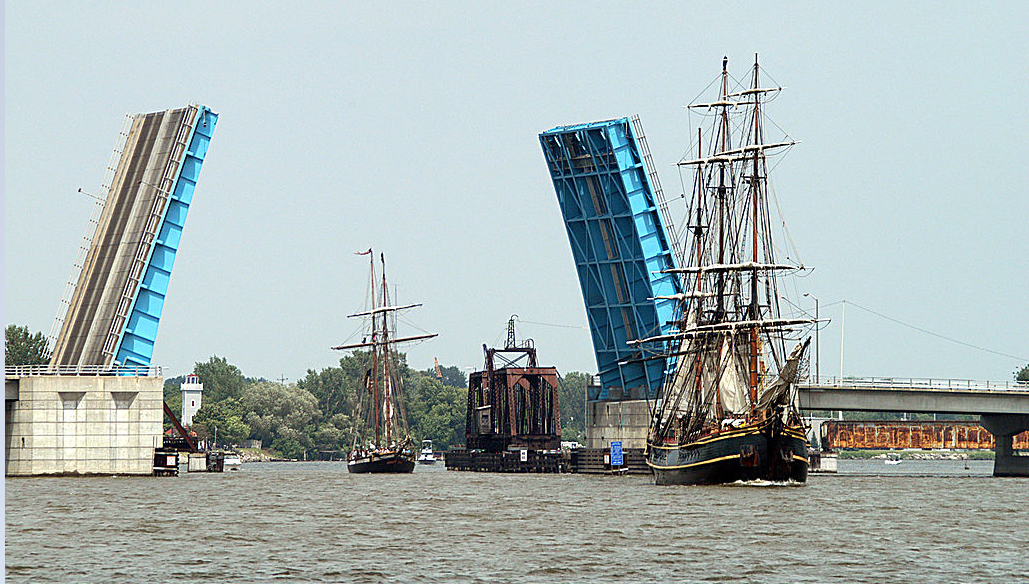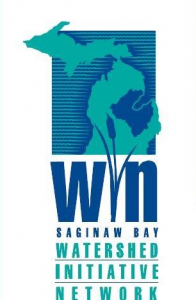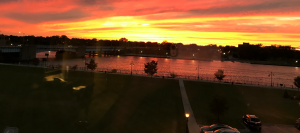
At the First Annual State of the Bay Conference in Bay City, Michigan, the algae that’s currently invading Maumee Bay near Toledo, Ohio seemed to hover over the gathering like a big green cloud.
200 people attended the first-ever conference of its kind at the Saginaw Bay watershed, which is one of 46 Areas of Concern listed by the EPA.
It’s the largest drainage basin in Michigan and it has suffered from the effects of the rise of industry in the early and mid-1900’s as well as pollution from agricultural run-off.
Today, the Saginaw Bay is undergoing a renaissance, especially along Bay City’s riverfront where the conference was held. New hotels, restaurants and luxury condos are being built along the shoreline. Tour boats and tall ships take tourists along the Saginaw River to see refurbished wetlands where American Egrets and Bald Eagles regularly appear.

SBWIN logo, courtesy of lccnetwork.org
The Saginaw Bay Watershed Initiative Network (SBWIN) leads the effort to promote sustainable development in the area by coordinating watershed programs and providing grants to innovative projects across the region. SBWIN, The Conservation Fund and the Cook Family Foundation joined together to create this conference.
Experts from throughout the Great Lakes Region shared lessons learned from programs involving everything from the Farm Bill and getting farmers to help reduce agriculture run-off to tracking aging sewage systems that leak into groundwater and the Great Lakes, to economic and recreational development along rivers and waterfronts, and dam removals and river remediation.
But keynote speaker Dr. Jeff Reutter, special advisor with the Ohio Sea Grant College Program at Stone Laboratory at Ohio State University, said Saginaw Bay can never fully recover unless its stewards learn lessons from Lake Erie.
“There are tremendous similarities. The Western Basin of Lake Erie is the warmest and most productive part of Lake Erie and the same can be said about Saginaw Bay as far as Lake Huron goes. “Reutter says, “It’s not only the southernmost, shallowest and warmest – it also gets a high concentration of nutrients – a high loading of nutrients -coming in from agricultural run-off and sewage treatment plants etcetera and when you get too much or too many of those nutrients you get start getting too much algae and the wrong kinds of algae, and you get harmful algae blooms like what we’re seeing in Toledo.”
Reutter warns, “This is really the time for you to learn from some of the things we’ve learned on Lake Erie so you can avoid the problems we’re having on Lake Erie right now.”
He says, “I’m very impressed with the Saginaw Bay watershed innovation network. It’s a great program. The projects that are being done… the partnerships they’ve created.. the fact that they’re all on one page. And I’m envious of the habitats you have in this watershed.”
Reuter told the attendees at the conference, “You CAN have a good economy and a clean environment.”
Tom Cook with the Cook Family Foundation who helped sponsor the conference tells Great Lake Now, “There’s both a high degree of interest in the Saginaw Bay and the Great Lakes and there are a large number of government people, non-profits and private individuals who really care about the Bay and are doing good work, and there are rare opportunities where we can all get together. It’s Michigan’s largest watershed, so you don’t always run into the other people doing work here. So when we’re given the opportunity, we jump at it.”
Cook says, “There’s a lot to be worried about. We look at Western Lake Erie and some of the challenges there – that’s a situation that can happen in other Great Lakes. But I have hope we can get in front of these issues. We need to keep rolling up our sleeves and getting to work.”

Sunset on Saginaw Bay, courtesy of Mary Ellen Geist
The one-day conference ended with a Water Ceremony conducted by the Saginaw Chippewa Indian Tribe (no photos or filming allowed) and then a cruise along the Saginaw River aboard the Appledore Tall Ship and Island Boats. As the conference ended, a brilliant sunset appeared along the Saginaw Bay.
1 Comment
-
When I went to lake eerie it was not as polluted and gross as saginaw bay or has it gotten worse?




